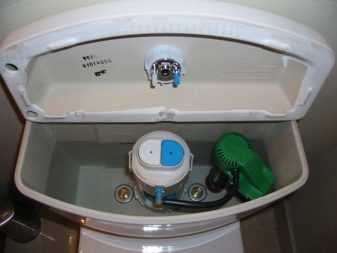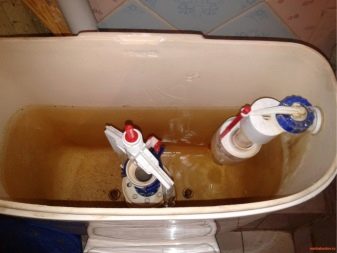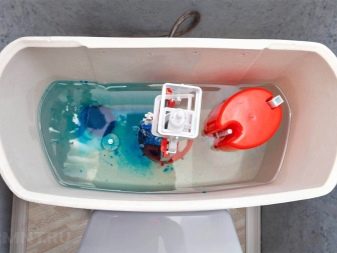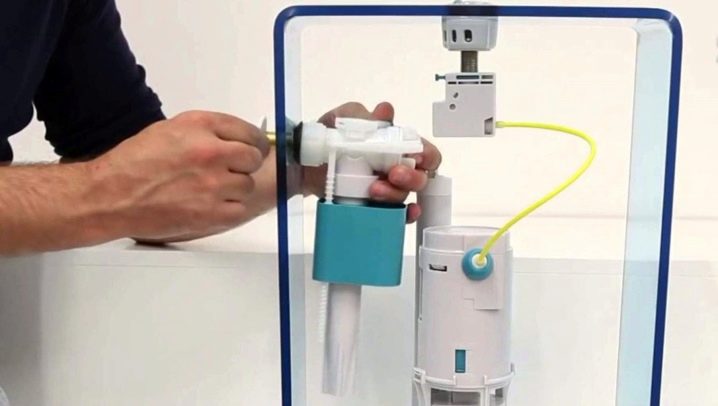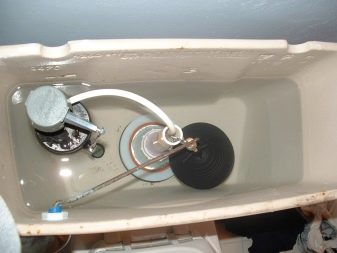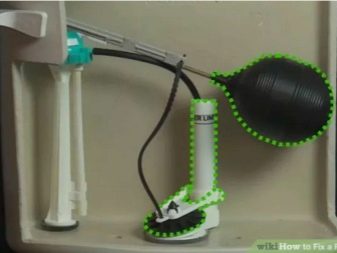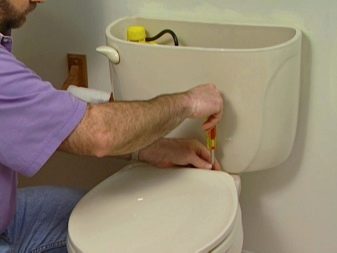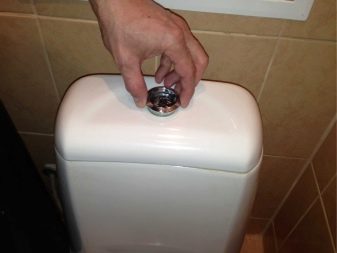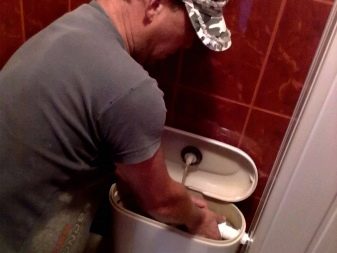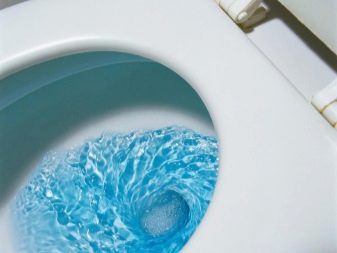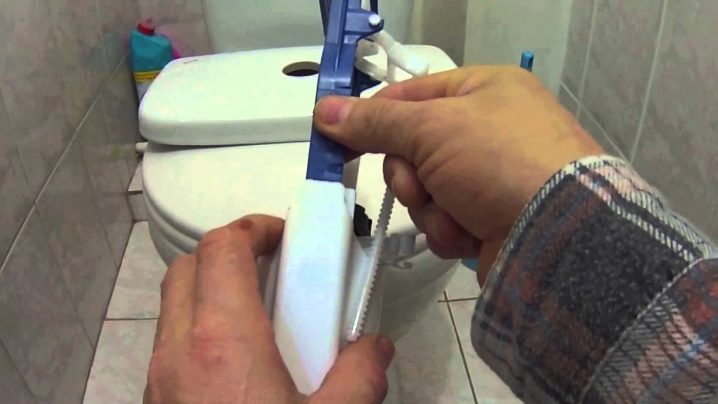Why the water in the toilet bowl is not collected: options for breakdowns
Before proceeding with the repair of the cistern, it is necessary to become familiar with its structure, main elements and principle of operation. This will contribute to the rapid detection of a fault. The drain tank is most often located at a short distance from the toilet bowl itself, and therefore the intense flow of water washes everything away from the bowl of the toilet bowl. In this construction, the pipeline is a connecting element between the cistern and the toilet.
Features and device
Increasingly, in the plumbing stores you can find a model that is one. There are products, which cisterns are disguised as a decorative partition. But despite the different appearance, the internal structure of the cistern remains the same.
The tasks of the internal structure of the drain tank are:
- fill the tank with water to the required mark - this is the most common cause of breakdowns;
- access to a full or selective toilet flush.
Water is flushed into the tank as follows:
- in order to resume the water supply, a float is used, which is fixed at the border of the lever;
- when the water is drained, the float goes down, sinks to the bottom of the tank and opens the channel, and water is supplied through it;
- as soon as it reaches a certain point, the float returns to its original location and closes the water supply channel.
There is a model that supplies water from below. In this model, the noise that occurs when filling with water from the drain tank can barely be heard. This model has a more difficult internal structure and high cost.
In the old model, in order to flush the water, the same method is used - the holes for flushing were covered with insignificant size valves or rubber pears. The lever, which went beyond the body, was connected with a chain. Consequently, when the lever was pulled, a drain hole opened and the water was flushed down the toilet.
Damage to these parts becomes the main factor causing long-term filling of water into the toilet bowl., most of which will go through the not completely covered drain hole. Repair of this design usually does not cause any difficulties - it is a simple and clear device. But this does not apply to the new modern model, which uses a different type of pipe fittings. It will allow you to adjust the intensity of the volume of washable water. For the operation of this mechanism involved a button, which consists of two parts, and each part is responsible for a different intensity of the flush.
In order to make a flush on the modern model of the toilet, there is no need to hold the button, as on the old plumbing fixture. One light touch is enough.
Causes of faults
A fairly common phenomenon is that it is impossible to discharge water in the drain tank or it is not filled with water.
The cause of these defects can be:
- the float is incorrectly located - one of the causes of an endless stream of water or a small volume of water when flushing;
- skewed float - this can happen in the case of very long exploitation;
- too slow filling of the tank with the lower eyeliner with water, sometimes also no water is poured at all;
- contamination of the internal parts of the water dispenser;
- continuous flow of water into the drain tank. Water goes to the toilet constantly and does not stop. This is bad, because all the water must be paid.
The cause of the fault may lie not only in the internal structure of the tank, but also outside it. For example, a source of slow filling of a tank with water may be blockage or pinching of pipes.
Remedies
Before you start repairing the tank, you must shut off the water supply from the water supply system.
Next, produce a certain algorithm of actions:
- Unscrew, using a wrench, the hose that connects the fluid supply pipe to the drain tank. Then check the water supply ability.
- Eliminate the blockage that appears. It is recommended for those faults when fluid flows through the hose, but does not fill the reservoir capacity. A blockage may occur in the area of the nozzle or in the area of its connection with the drain hole. Clean it using a long nail or any other sharp object.
- After all the manipulations performed, attach the hose to the drain tank and check if the barrel is filled with water.
The termination of the float for two reasons. The first is that the float does not supply water to the tank and does not tightly cover its flow. Both faults may involve both the float and the valve. The structure of the float depending on the model of the cistern can vary. It can be hollow inside or resemble an inverted glass. A hollow float is usually the fastest problem. This is due to the fact that water drops fall into it. In this situation will help his complete replacement. The float in the form of glass after a short period of time begins to actively accumulate particles of dirt on its surface, which also provokes the failure of the entire drainage device. Repair in this case consists in careful washing of a float.
If the pipeline fittings that are designed to shut off water are contaminated, it may not cope with its functional purposes. This is due to clogging of the membranes or holes that allow fluid to move.To solve the problem it is necessary to disassemble the float. All membrane channels are washed and inserted into the original place, then the cap is screwed on. Despite the simplicity of this repair process, it is much more practical and more expedient to replace the membrane. This item is often an optional accessory in a kit with a new float.
To regulate the location of the float is recommended to do some simple steps. To begin, fill the drain tank and track the level at which the water rises. The ideal option is water, which is located five centimeters below the side opening of the drain tank. Make sure that the water slightly covers the drain housing. To obtain the required water level and for correct operation of the cistern can be achieved by raising and lowering the float. By raising the float, you will increase the amount of water being filled, and by releasing the float, you will lower it accordingly.
In case of a malfunction with the drain mechanism, the difficulty arising from the malfunction of the drain device leads to an endless flow of water.There are cases when lowering the tube is lower than required, which allows the float to collect an unnecessary amount of water. The tube is adjusted by lifting it. Sometimes this is sufficient, but in other cases a specialized reconfiguration of the location of the overflow details will be required. In a situation where the rubberized valve stops restraining water - it is either clogged or dry. To solve the problem it is recommended to disassemble the device of the drain tank. At the same time to shoot it is not necessary. Drain tank effortlessly separated into two parts. It is necessary to clean the drain hole and the valve itself. After that, the drain tank is going to its former state.
When leaking in the area between the cistern and the toilet, it is recommended to replace all rubberized gaskets and seals for fasteners. To implement this procedure, you need to detach the drain tank. If you find a malfunction in the locking elements of the device, then in this case a complete replacement of non-working parts is carried out.
Consequences of inaction
It is necessary to do something if the tank is broken and the water has ceased to act correctly.In case you notice that the drain tank is defective or does not do so well with the work, as before, do not neglect its repair. In addition to the fact that most likely you harm all the equipment of your bathroom, there is a possibility of damage to the bathroom of people living under you. In other words, the drain tank, which is not able to fill itself with water, provokes the flow of water into the area, which is designed for the waste products of the human body. It is connected to the drain tank with a tube. There is a possibility that the tube may start leaking, which will definitely provoke the flooding of your neighbors.
In addition, if you ignore the first signs of overly slow filling of the tank with water, after some time you may encounter the fact that the water stops flowing altogether, which is an unpleasant pleasure, given the main function of this device - flushing.
You should know that a completely running device cannot be repaired. Consequently, there is a need to acquire a new mechanism and its subsequent mounting. And these are new efforts and expenses.
Valve replacement
It is possible to fix the unit if you constantly monitor it and, if necessary, use our recommendations.
To replace valves, you must:
- Begin disassembling with the determination of the internal diameter of the sewer pipe that supplies water. Proper diameter finding will simplify the purchase of new parts.
- In case of difficulties with the determination of the desired diameter will help visual inspection. Lift the tank lid and get an identical design from the plumbing shop. Armature for flush tank is often sold in a set.
- Before installing a new device, it is imperative to turn off the water supply that enters the bowl of the toilet bowl, remove the roof of the cistern and wash off all remaining water.
- To dismantle the old device, unscrew the flexible hose, while holding the old fittings.
- Inspect the used gaskets and rubber seals, in case of unsuitability, replace with new ones.
- Install the new water fittings so that it does not touch the walls of the cistern and does not touch the drain mechanism.
- Open the fluid supply.
- After connecting the water, some adjustment of the mechanism may be necessary, for example,tighten the nut at the membrane or a slight adjustment to the location of the float.
Tips and tricks
One of the reasons for the failure of the drain tank is the clogging of internal parts in the water fittings. In order to avoid this kind of trouble in the future, it is necessary as a prophylaxis to scrape away the deposited limescale or rust deposited on the walls of the cistern.
To start cleaning, it is recommended to turn off the water and flush the water remaining in the tank. For convenience, you can remove the float and drain lever. They are also recommended to thoroughly wash with any cleaning agent. To clean the tank, fill it with soapy water or a specialized cleaning agent and leave for 30-60 minutes. After the time, the tank walls are cleaned using a brush, a hard rag or a sponge. If you have achieved the desired result, reinstall the float and the drain lever.
For heavy soiling, it is necessary to use more aggressive cleaning agents.
- Detergents with abrasive particles, which contain tiny grains of chalk, quartz sand and pumice.
- Funds based on acids.The most practical and effective will be the use of hydrochloric acid. To effectively remove rust and plaque, it is recommended that all contaminated sites be thoroughly treated with acid. Do not forget to wash away the water in advance. Then leave the solution for half an hour. After this procedure, there is usually no difficulty with further cleaning. It will be enough to hold a rigid cloth on the surface of the entire tank. Repeat the procedure if necessary.
- Cleaning agents based on alkali, for example, sodium hypochlorite. The cleaning method is similar to acidic products.
Most of the faults in the drain tank device do not require specialized intervention in the face of the plumber. Much you can fix yourself at home. This will save you from unnecessary costs and will guarantee the correct operation of water fittings, which for some reason does not work correctly.
See why the water in the toilet bowl is not collected in the next video.



